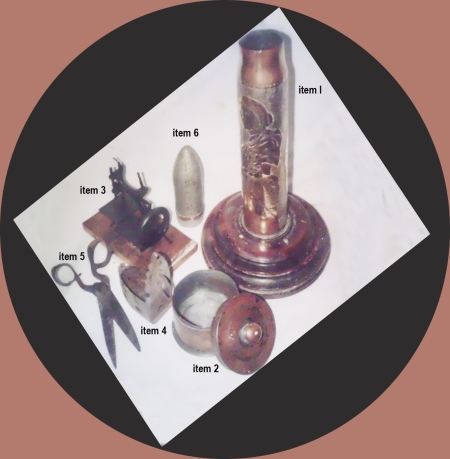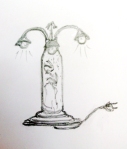My family originated from the small, tadpole-shaped island of Corregidor in the Philippines. Now a National Shrine, it was the last island to surrender to the Japanese during World War II. How the civilian people lived there before the war were all tales from my parents and siblings, eight of whom were born there. Some documents and crafts remain that tell of their lives there. The Island became a military stronghold of the Americans when they came, and decided to stay after a mock battle in Manila Bay with the Spaniards in 1898. To help in fortifying the island they named Fort Mills, most of the original inhabitants remained to work with the Americans. One of them was my father who, during his leisure hours engaged in fishing and “bullet crafting.”

Artifacts made, used and found in Corregidor Island, Philippines before 1941. They now form part of the exhibit in the Island’s War Museum located at Topside. Items 1, 2 [made of mortar bullets] and Item 5 were my father’s handiwork.
 Because of its weight and bulkiness, only its tube was saved from the War. His work is dated 1928. His other metallurgic work was a talcum powder container made of mortar base plate [Item 2]. With a heavy lid and appearing to be of bronze material, it must have father’s gift to my mother. The pair of scissors [Item 3] was also crafted by my father.
Because of its weight and bulkiness, only its tube was saved from the War. His work is dated 1928. His other metallurgic work was a talcum powder container made of mortar base plate [Item 2]. With a heavy lid and appearing to be of bronze material, it must have father’s gift to my mother. The pair of scissors [Item 3] was also crafted by my father.
All of them can be found with some civilian prewar documents in a small room at the War Museum of the Corregidor Historical Shrine. Toys like the Singer sewing machine, a flat iron that uses charcoal are also displayed in the museum [Items 3 & 4]. All that remained in our possession related to their lives in Corregidor after the fire that destroyed our house in 1998 were donated to the Museum. Fear of another fire tragedy greatly motivated me to donate, not keep the remaining artifacts with us. Most of them are burnt-looking if you will notice because they actually went aflame at that time. I just retrieved them for sentimental reason. One of my father’s creations, a lighthouse about 16” in height, also made in Corregidor fully melted in that fire incident, and of course their pictures during the American period.
The other reason for giving them away is for visitors – local and foreign — to see, or give them concrete idea on how people lived in the island before. No books comprehensively tackle about the civilian lives before 1941. All are centered on the War, and, especially the Fall of Corregidor; to be more precise most of the books focus on the fall or the surrender of the Americans to the Japanese, especially so, on the return of Gen. Douglas McArthur. That’s exactly why I was led to do my first feature-length docu, TIGA-ISLA [The Islanders of Corregidor]. Using oral history, I focused on the socio-cultural lives of the American servicemen, Philippine Scouts and civilians that included my family. But what sparked me the most to work on it was when I visited the island sometime in 2000. Balikbayan Filipinos [specifically those who immigrated to the US] were completely surprised to know that there were villagers in the island, and that it was actually inhabited before. As I’ve said, lack of materials on prewar lives in the island cause that ignorance even up to now. Currently, only hotel workers and maintenance personnel live there.
Corregidor is a must-see historical shrine in our country. I am not saying that because of my affinity to it but because it is one of the actual reminders of the horrors of World War II. It is being kept and preserved by Corregidor Foundation. Unfortunately, the forces of Nature are slowly eroding the structures there including what is called Mile-long Barracks, said to be the longest barracks in the world [http://www.malinta.com/corregidor/milelong.htm].
http://dailypost.wordpress.com/2013/02/01/photo-challenge-unique/

